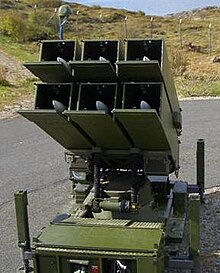 |
| AIM-120 AMRAAM |
The AMRAAM is the world's most popular beyond-visual-range missile, with more than 14,000 produced for the United States Air Force, United States Navy, and 33 international customers in 2008. AMRAAM was used in several engagements and is credited with ten aerial victories. Now over 30 years old in its design, the AMRAAM is scheduled to be replaced by the newer AIM-260 JATM in the mid-2020s to provide better performance and capabilities to defeat electronic jamming.
System Specifications
- Missile type: Medium-range air-to-air missile
- Builder: Hughes / Raytheon
- Unit cost: US$386,000
- Deployment: September 1991
- Features:
- Engines: solid fuel rocket
- Launch mass: 152kg _
- Length: 3.66m _
- Diameter: 0.178m _
- wingspan: 0.526m _
- Speed: Mach 4 (4,900 km/h; 3,000 mph)
- Operational
- range: AIM-120A/B: 50–70km, AIM-120C: 50–120km and AIM-120D: 50–180+ km
- Payload : 18 kg of WDU-41/B fragmentation explosive (23 kg AIM-120A/B)
- Guidance: active radar , inertial guidance
- Launch platform:
Development
Improvements
All versions combined, approximately 17,500 AIM-120s were produced in .
In 2019, the United States Armed Forces is scheduled to purchase its last batch of AIM-120s in 2026, with the latter theoretically to be replaced by the AIM-260 JATM.
Ground-to-air development
In view of the quality of this missile, it was decided to extrapolate a surface-to-air version of air defense designed by the Norwegian company Kongsberg Defense & Aerospace. The designation MIM-120A is sometimes used, but is not official. The first to be equipped with it were the Norwegians, with the NASAMS system, which carries 6 weapons. It has been operational since 1995. This system and an improved version, the NASAMS II, were ordered in 2009 for Spain, Finland, and the Netherlands.
Guidance
The first third of the missile is made up of the guidance system. First, there is the antenna, under a conical dome. Behind it are placed the batteries that power the system, then the guidance electronics itself. The missile is a "fire and forget" type, which means that once the missile is fired, it is completely autonomous. When fired, the aircraft's weapon system transmits the coordinates of the target to the missile. These coordinates usually come from the launcher's radar, but can also be provided by an infrared detection system, from another aircraft equipped with a data link, or even from an AWACS.
The missile then calculates an intercept trajectory and heads towards the point of impact thanks to inertial guidance ( INS ). However, if the firing aircraft continues to illuminate the target using its radar, the missile trajectory is updated. Some air forces did not express the wish to have this update option; thus, the Royal Air Force found that without this update, the effectiveness of the AIM-120 was lower than that of the BAe Sky Flash, which it replaces.
Once the target comes within range of its radar, the missile switches to active guidance. The seeker springs into action, finds the target, and locks onto it. NATO airmen nickname this mode Pitbull because it no longer drops its target. If the missile is fired at close range, it goes directly into active mode and is therefore very effective.
Warhead
The warhead consists of 23 kg of fragmentation explosive for the AIM-120A and AIM-120B versions, called WDU-33/B. The AIM-120C version is equipped with the WDU-41/B warhead made up of 18 kg of fragmentation explosive.
Propulsion
The AIM-120A and the AIM-120B are equipped with a solid-fuel rocket engine, allowing them to reach a range of 75 km and a speed of Mach 4. The AIM-120C, as for him, has a larger engine to reach 110 km. Little information is available on this engine, whose official name is WPU-6/B for the AIM-120A/B versions and WPU-16/B for the AIM-120C.
Releases
- YAIM-120A: Initial program for an active-guided medium-range missile;
- AIM-120A: First version;
- AIM-120B: WGU-41/B guidance system;
- AIM-120C: Shortened ailerons, WGU-44/B guidance;
- AIM-120C4: Warhead WDU-41/B;
- AIM-120C5: WDU-41/B warhead, WPU-16/B propulsion, 110 km range;
- AIM-120C6: New trigger system;
- AIM-120C7: Improved range and guidance, testing completed in 2007;
- AIM-120D: In-flight GPS updating, data link, extended firing envelope, initial operational capability in ;
- "MIM-120A": Ground-to-air version used in the Norwegian NASAAM, CLAWS and American SLAMRAAM systems.
Vectors
- AV-8B Harrier II
- F-4 Phantom ( Germany only)
- Eurofighter Typhoon
- F-16 Fighting Falcon (all versions)
- Panavia Tornado
- F/A-18 Hornet (all versions)
- F-14 Tomcat (trials only)
- F-15 Eagle (C, I and S versions only)
- F-22 Raptor
- F-35 Lightning
- Saab JAS 39 Gripen
- NASAMS ground platform










0 Comments